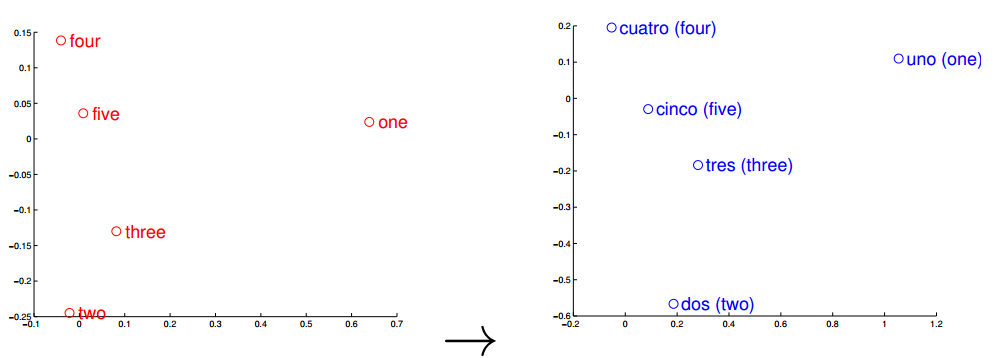Representations of complicated spaces by vectors which preserve semantic information.
Warning: this is not my current area, but it is a rapidly moving one.
Treat notes here with caution; many are outdated.
Feature construction for inconvenient data; made famous by word embeddings such as word2vec being surprisingly semantic. Note that word2vec has a complex relationship to its documentation and now even more famous for LLMs.
But what do these vectors mean? I am not sure. One interesting approach is to use Sparse autoencoders to understand the vectors.
Skip-grams and related context models
As invented by (Bengio et al. 2003) and popularised/refined by Mikolov and Dean at Google, the skip-gram semantic vector spaces is a useful way to define String distances for natural language this season.
Rutger Ruizendaal wrote a tutorial on learning embedding layers.
Christopher Olah discusses RNN embeddings from a neural network perspective with diagrams and commends (Bengio et al. 2003) for a rationale.
Sanjeev Arora’s semantic word embeddings has an explanation of skipgrammish methods:
In all methods, the word vector is a succinct representation of the distribution of other words around this word. That this suffices to capture meaning is asserted by Firth’s hypothesis from 1957, “You shall know a word by the company it keeps.” To give an example, if I ask you to think of a word that tends to co-occur with cow, drink, babies, calcium, you would immediately answer: milk.
[…] Firth’s hypothesis does imply a very simple word embedding, albeit a very high-dimensional one.
Embedding 1: Suppose the dictionary has N distinct words (in practice, N=100,000). Take a very large text corpus (e.g., Wikipedia) and let Count5(w1,w2) be the number of times w1 and w2 occur within a distance 5 of each other in the corpus. Then the word embedding for a word w is a vector of dimension N, with one coordinate for each dictionary word. The coordinate corresponding to word w2 is Count5(w,w2). (Variants of this method involve considering cooccurence of w with various phrases or n-tuples.)
The obvious problem with Embedding 1 is that it uses extremely high-dimensional vectors. How can we compress them?
Embedding 2: Do dimension reduction by taking the rank-300 singular value decomposition (SVD) of the above vectors.
Using SVD to do dimension reduction seems an obvious idea these days but it actually is not. After all, it is unclear a priori why the above N×N matrix of cooccurance counts should be close to a rank-300 matrix. That this is the case was empirically discovered in the paper on Latent Semantic Indexing or LSI.
Anonymous Quora user:
For both descriptions below, we assume that the current word in a sentence is \(w_i.\)
CBOW: The input to the model could be \(w_{i-2}, w_{i-1}, w_{i+1}, w_{i+2},\) the preceding and following words of the current word we are at. The output of the neural network will be \(w_i\). Hence you can think of the task as “predicting the word given its context”. Note that the number of words we use depends on your setting for the window size.
Skip-gram: The input to the model is \(w_i\), and the output could be \(w_{i-1}, w_{i-2}, w_{i+1}, w_{i+2}\). So the task here is “predicting the context given a word”. Also, the context is not limited to its immediate context, training instances can be created by skipping a constant number of words in its context, so for example, \(w_{i-3}, w_{i-4}, w_{i+3}, w_{i+4}\), hence the name skip-gram. Note that the window size determines how far forward and backward to look for context words to predict.
According to Mikolov:
Skip-gram: works well with small amount of the training data, represents well even rare words or phrases.
CBOW: several times faster to train than the skip-gram, slightly better accuracy for the frequent words.
This can get even a bit more complicated if you consider that there are two different ways how to train the models: the normalized hierarchical softmax, and the un-normalized negative sampling. Both work quite differently.
which makes sense since with skip gram, you can create a lot more training instances from limited amount of data, and for CBOW, you will need more since you are conditioning on context, which can get exponentially huge.
Jeff Dean’s CIKM Keynote. (that’s “Conference on Information and Knowledge Management” to you and me.)
“Embedding vectors trained for the language modeling task have very interesting properties (especially the skip-gram model)”
\[
E(\text{hotter}) - E(\text{hot}) &≈ E(\text{bigger}) - E(\text{big}) \\
E(\text{Rome}) - E(\text{Italy}) &≈ E(\text{Berlin}) - E(\text{Germany})
\]
“Skip-gram model w/ 640 dimensions trained on 6B words of news text achieves 57% accuracy for analogy-solving test set.”
Sanjeev Arora explains that, more than that, the skip gram vectors for polysemic words are a weighted sum of their constituent meanings.
Skip thought vectors:
We describe an approach for unsupervised learning of a generic, distributed sentence encoder. Using the continuity of text from books, we train an encoder/decoder model that tries to reconstruct the surrounding sentences of an encoded passage. Sentences that share semantic and syntactic properties are thus mapped to similar vector representations. […] The end result is an off-the-shelf encoder that can produce highly generic sentence representations that are robust and perform well in practice
Graph formulations, e.g. David McAllester, Deep Meaning Beyond Thought Vectors:
I want to complain at this point that you can’t cram the meaning of a bleeping sentence into a bleeping sequence of vectors. The graph structures on the positions in the sentence used in the above models should be exposed to the user of the semantic representation. I would take the position that the meaning should be an embedded knowledge graph — a graph on embedded entity nodes and typed relations (edges) between them. A node representing an event can be connected through edges to entities that fill the semantic roles of the event type
Misc
Entity embeddings of categorical variables (code):
We map categorical variables in a function approximation problem into Euclidean spaces, which are the entity embeddings of the categorical variables. The mapping is learned by a neural network during the standard supervised training process. Entity embedding not only reduces memory usage and speeds up neural networks compared with one-hot encoding, but more importantly by mapping similar values close to each other in the embedding space it reveals the intrinsic properties of the categorical variables. We applied it successfully in a recent Kaggle competition and were able to reach the third position with relative simple features. We further demonstrate in this paper that entity embedding helps the neural network to generalize better when the data is sparse and statistics is unknown. Thus it is especially useful for datasets with lots of high cardinality features, where other methods tend to overfit. We also demonstrate that the embeddings obtained from the trained neural network boost the performance of all tested machine learning methods considerably when used as the input features instead. As entity embedding defines a distance measure for categorical variables it can be used for visualising categorical data and for data clustering.
Other Software
word2vec
This tool provides an efficient implementation of the continuous bag-of-words and skip-gram architectures for computing vector representations of words. These representations can be subsequently used in many natural language processing applications and for further research.”
fastText
fastText is a library for efficient learning of word representations and sentence classification.
References
Bender, and Koller. 2020.
“Climbing Towards NLU: On Meaning, Form, and Understanding in the Age of Data.” In
Proceedings of the 58th Annual Meeting of the Association for Computational Linguistics.
Bengio, Ducharme, Vincent, et al. 2003.
“A Neural Probabilistic Language Model.” Journal of Machine Learning Research.
Cancho, and Solé. 2003.
“Least Effort and the Origins of Scaling in Human Language.” Proceedings of the National Academy of Sciences.
Deerwester, Dumais, Furnas, et al. 1990.
“Indexing by Latent Semantic Analysis.”
Guthrie, Allison, Liu, et al. 2006.
“A Closer Look at Skip-Gram Modelling.” In.
Herremans, and Chuan. 2017.
“Modeling Musical Context with Word2vec.” In
Proceedings of the First International Conference on Deep Learning and Music, Anchorage, US, May, 2017.
Kiros, Zhu, Salakhutdinov, et al. 2015.
“Skip-Thought Vectors.” arXiv:1506.06726 [Cs].
Le, and Mikolov. 2014.
“Distributed Representations of Sentences and Documents.” In
Proceedings of The 31st International Conference on Machine Learning.
Mikolov, Chen, Corrado, et al. 2013.
“Efficient Estimation of Word Representations in Vector Space.” arXiv:1301.3781 [Cs].
Mitra, and Craswell. 2017.
“Neural Models for Information Retrieval.” arXiv:1705.01509 [Cs].
Mollo, and Millière. 2023.
“The Vector Grounding Problem.”
Narayanan, Chandramohan, Venkatesan, et al. 2017.
“Graph2vec: Learning Distributed Representations of Graphs.” arXiv:1707.05005 [Cs].
Nunes, and Antunes. 2024.
“Machines of Meaning.”
Pennington, Socher, and Manning. 2014.
“GloVe: Global Vectors for Word Representation.” Proceedings of the Empiricial Methods in Natural Language Processing (EMNLP 2014).

